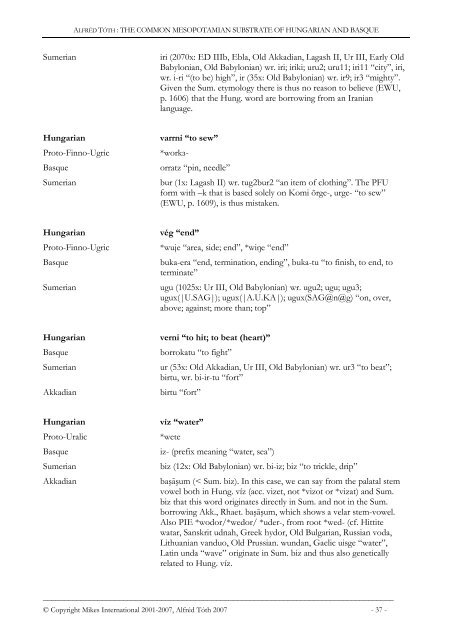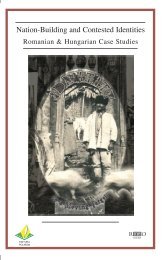The common Mesopotamian substrate of Hungarian and ... - MEK
The common Mesopotamian substrate of Hungarian and ... - MEK
The common Mesopotamian substrate of Hungarian and ... - MEK
Create successful ePaper yourself
Turn your PDF publications into a flip-book with our unique Google optimized e-Paper software.
ALFRÉD TÓTH : THE COMMON MESOPOTAMIAN SUBSTRATE OF HUNGARIAN AND BASQUE<br />
Sumerian<br />
iri (2070x: ED IIIb, Ebla, Old Akkadian, Lagash II, Ur III, Early Old<br />
Babylonian, Old Babylonian) wr. iri; iriki; uru2; uru11; iri11 “city”, iri,<br />
wr. i-ri “(to be) high”, ir (35x: Old Babylonian) wr. ir9; ir3 “mighty”.<br />
Given the Sum. etymology there is thus no reason to believe (EWU,<br />
p. 1606) that the Hung. word are borrowing from an Iranian<br />
language.<br />
<strong>Hungarian</strong><br />
Proto-Finno-Ugric<br />
Basque<br />
Sumerian<br />
varrni “to sew”<br />
*workз-<br />
orratz “pin, needle”<br />
bur (1x: Lagash II) wr. tug2bur2 “an item <strong>of</strong> clothing”. <strong>The</strong> PFU<br />
form with –k that is based solely on Komi õrge-, urge- “to sew”<br />
(EWU, p. 1609), is thus mistaken.<br />
<strong>Hungarian</strong><br />
Proto-Finno-Ugric<br />
Basque<br />
Sumerian<br />
vég “end”<br />
*wuje “area, side; end”, *wiŋe “end”<br />
buka-era “end, termination, ending”, buka-tu “to finish, to end, to<br />
terminate”<br />
ugu (1025x: Ur III, Old Babylonian) wr. ugu2; ugu; ugu3;<br />
ugux(|U.SAG|); ugux(|A.U.KA|); ugux(SAG@n@g) “on, over,<br />
above; against; more than; top”<br />
<strong>Hungarian</strong><br />
Basque<br />
Sumerian<br />
Akkadian<br />
verni “to hit; to beat (heart)”<br />
borrokatu “to fight”<br />
ur (53x: Old Akkadian, Ur III, Old Babylonian) wr. ur3 “to beat”;<br />
birtu, wr. bi-ir-tu “fort”<br />
birtu “fort”<br />
<strong>Hungarian</strong><br />
Proto-Uralic<br />
Basque<br />
Sumerian<br />
Akkadian<br />
víz “water”<br />
*wete<br />
iz- (prefix meaning “water, sea”)<br />
biz (12x: Old Babylonian) wr. bi-iz; biz “to trickle, drip”<br />
başāşum (< Sum. biz). In this case, we can say from the palatal stem<br />
vowel both in Hung. víz (acc. vizet, not *vizot or *vizat) <strong>and</strong> Sum.<br />
biz that this word originates directly in Sum. <strong>and</strong> not in the Sum.<br />
borrowing Akk., Rhaet. başāşum, which shows a velar stem-vowel.<br />
Also PIE *wodor/*wedor/ *uder-, from root *wed- (cf. Hittite<br />
watar, Sanskrit udnah, Greek hydor, Old Bulgarian, Russian voda,<br />
Lithuanian v<strong>and</strong>uo, Old Prussian. wundan, Gaelic uisge “water”,<br />
Latin unda “wave” originate in Sum. biz <strong>and</strong> thus also genetically<br />
related to Hung. víz.<br />
___________________________________________________________________________________<br />
© Copyright Mikes International 2001-2007, Alfréd Tóth 2007 - 37 -

















